|
Kentucky Blue Jock
$1000 with FREE SHIPPING
Kentucky is the lawn jockey and hitching post capitol of the world!
The Kentucky Blue Jock represents the American Thoroughbred racing traditions of the bluegrass state - "painted fancy" in
a traditional jockey silk design of blocks and stripes. Lawn jockeys and horse head hitching posts are a Kentucky tradition alongside bourbon, basketball, and "my old Kentucky home".
The lawn jockey has a long tradition around Lexington in particular, where some of the first jockey's were "painted fancy" and used at many horse farms in the area as hitching posts and used at businesses as attention-grabbing "trade figures" starting in the 1870's.
These were solid iron jockey figures with hand outstretched holding a ring.
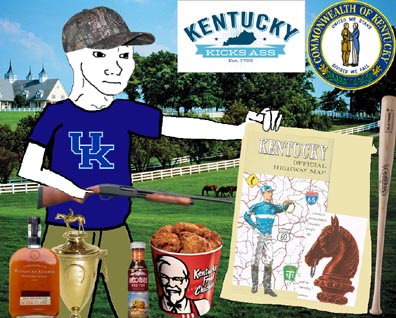
Click on picture for larger view.
Bobby Swim
A short story based on unusual actualities in Lexington, Kentucky in June 1910
by Hoss Head
"Paint Bobby Swim again!", said Coley Lancaster, new owner of the Berlin Café, a drinking establishment on North Limestone street in downtown Lexington, Kentucky on the afternoon of June 1, 1910. "Make it a green jacket, orange sash and green cap," he instructed the painter.
The cast iron jockey statue about to be repainted had stood as a Lexington landmark at the same spot in front of Lancaster's saloon since May 1876, set there by the original owner David Clohesy, and had been repainted many times.
When he owned the bar, Clohesy had called the jockey a "statue of Bobby Swim", inspired by the champion of the second running of the Kentucky Derby in nearby Louisville in April 1876. Clohesy was a pioneer in using the jockey hitching post as a trade figure since the
jockey casting had only been invented 5 years prior in 1871. Not much is known of the jockey Bobby Swim today except for his 1876 Kentucky Derby triumph, his second place Derby finish in
1877 and third place finish in 1878. In 1910, old timers remembered there was a big crowd at Clohesy's place on the day the statue of Bobby Swim was unveiled with great fanfare that May day in 1876. Clohesy treated all his patrons at the statue unveiling to a round of Kentucky bourbon "on the house". The crowd drank to the health of Swim, the horse's
owner Price McGrath and "the turf" in general. Unfortunately for Swim, the toast did not work out as he tragically died young of consumption(alcohol abuse) shortly thereafter in 1878.
However, horse racing and Clohesy's tavern did prosper in Lexington over the following decades. Even after Swim's notable exploits in the saddle faded from memory and he was no longer the talk of the town, as long as Clohesy owned the saloon the statue
stood unchanged, "painted fancy" in green and orange colors to look exactly like Bobby Swim. But after Clohesy's death in 1890, new ownership of the tavern painted over Bobby Swim's colors and subsequent bar owners followed, each changing the colors of the hitching post to their taste. Rust began to peek through
some areas of peeling paint. The century turned- horse racing was in decline as a series of anti-gambling laws took effect. The bar on North Limestone Street was still open and the now rusty hitching post still remained but the legend of Bobby Swim was long forgotten... or was it?
"Whose colors are these?", an old timer asked as he passed Lancaster and the painter on North Limestone street just as the painter was putting the finishing touches to the brand new looking green and orange jockey.
"Why Price McGrath's. Bobby Swim wore them colors when he rode McGrath's hoss to the Derby victory back in '76", replied Lancaster. "No they're not", angrily remarked the old timer, Dr. Tennessee Jones, who was an archeology professor from the University of Kentucky, "You need an orange stripe on that cap to make them McGrath's colors!"
The argument became heated as professor Jones proceeded into a long winded lecture recounting a series of "indisputable facts" that definitively "proved without a doubt" that there was indeed an
orange stripe on the jockey's cap.
Two UK fraternity boys, recognizing the professor from their classroom stopped by to listen and became instant "yes men" to the professor, throwing their fists in the air and heckling after each of the his pronouncements "Stripe makes right!", referencing the best selling book of the day "Might makes right".
Meanwhile, the bar mascot dog "Bobby", a Scottish terrier(named after "Greyfriars Bobby" the famous terrier of Edinburgh, Scotland, not the jockey) came over to the freshly painted statue and peed on it. The painter frowned.
There were other detractors. A mechanic wearing a black "beanie" cap with jagged brim from the local garage pointed at the statue with his black greasy finger and said, "Why you repainting dat hoss jockey? You should paint him as a CAR jockey 'cause CARS will be tha only thing that will be going around a track in a few years!"
Passersby stopped to see what all the fuss was about and soon old professor Jones had turned into a street preacher sermonizing to his growing flock on the subject of the jockey's "wrongly painted cap".
Bystanders began to debate the professor's claims. A policeman on his beat stepped in to contradict the professor, saying he used to leap-frog the jockey as a boy and he remembered the cap was green- "all green just like a frog!", he said as he pointed his billy club at the top of the professor's
gray head with exaggerated menace.
A bootstrappy red-haired news boy noticed the growing crowd and commotion at the bar and came over to sell newspapers, shouting "EXTRA EXTRA, BERLIN BAR, JOCKEY WAR!" over and over again.
This attracted even more pedestrians to the crowd in front of the bar.
A middle aged Irish charwoman, the newsboy's mother, who had just finished her cleaning duties at an upstairs apartment heard her son's yelling and came down to confront the policeman with a wagging finger and saying, "I be but a poor tongue-tied laborer from the land of the bogs and the little people, but me pappy God rest his soul knew ye master McGrath of
de Clan McGrath of Munster county in me home country with de flag of green, white and orange... and Bly me, jockey Swim must have had an orange stripe on his head cause I remember my pappy telling me watchin' Swim ridin' de harse down de track was like watchin' de Irish flags flying down the streets in de Saint Patrick's Day parade!"
The Berlin Café grew busy as the cap argument spilled inside so Coley Lancaster had to leave and help his co-owner brother Henry bartend. When he came back outside an hour later the professor, the painter, and the policeman had all left.
The newspaper urchin was already back at the Lexington Herald office telling his editor about the breaking "jockey war" news. The bloviating professor had won the day- "Bobby Swim" was now painted... with an orange
stripe on top of his cap.
The orange stripe controversy continued inside the Berlin Cafe that week however, as patrons became divided into "stripers" and "never stripers" camps. There were scores of arguments between the stripers and never stripers over the cap configuration with many wagers made on the proposition.
As a generation had passed since Swim made his famous Derby ride and no picture or other reference sources existed, arguments relied heavily on second hand oral history... or who could make the most lawyer-like argument after the previous round of bourbon.
As the days passed the jury was still out so to settle the arguments(and bets), Lancaster finally visited the Lexington public library, and after an exhaustive search located a dusty antique racing guide book in which read:
"H.P. McGrath, Lexington, KY., Green jacket, orange sash, green cap"
Coley Lancaster checked out the book from the library so no one else could discover the valuable information hidden between it's covers and kept the news a secret to everyone except his brother. Ever the marketing genius, he announced the next day that there would be a grand unveiling of the "correctly painted statue" along with "proof of correct colors" and "drinks on the house" at 3pm on June 8th, 1910.
Tension mounted between the stripers and never stripers as the date approached. Pedestrians along North Limestone street on the morning of June 8th were surprised to see the jockey statue was now bound with thick rope over a red checkerboard oil cloth tablecloth with the policeman hovering over it to guard against any "peeking".
Lancaster himself had secretly painted over the orange stripe on Bobby Swim's cap the night before, so only he and his brother knew of the final cap configuration.
At about 8am, Henry Lancaster appeared at the local print shop(which also printed the newspaper) with a peculiar request of making 300 copies of a page from an antique book. "We are making these as our new placemats", Henry said. "Placemats?", the bewildered printer responded.
He had seen many unusual requests but completely re-typesetting an entire page from an antique book to make a placemat topped the list! However, he humored his eccentric patron and didn't make a connection between the printing job and the scheduled event at Berlin Café later that day.
At about noon when the horse-drawn print shop delivery wagon stopped in front of the café on Limestone street, the delivery man
was upset the jockey was covered in oil cloth and not available to tie his horse to, with the policeman standing beside it. "You can't park your horse here", said the policeman. The print shop wagon continued down Limestone street until the next suitable post was found in front of the meat market. The driver alighted the wagon, tied up his horse and delivered his package, wrapped in brown paper and tied with a string
to Henry inside the bar.
Newspaper headlines promoted the already much anticipated statue unveiling and the area around the statue slowly transformed into a circus atmosphere. The now famous red-haired newsboy arrived by the policeman's side selling the evening edition as the crowd grew. The newsboy garnered a big laugh from the crowd when he suddenly pulled off his hat to reveal he had dyed both sides of his head green leaving a stripe of his natural red hair in the middle to look like the jockey.
His mother the charwoman frowned and wagged her finger at him.
At 3 pm, Coley Lancaster got on top of a chair brought out from the bar. Like a Barnum and Bailey ringmaster he waved to the crowd and acknowledged his "regulars" in the audience by pointing his finger at them, then to his head, then giving a "thumbs up" sign. Lancaster then spotted professor Jones in the crowd and waved at him to come up "on stage". The professor obliged and another chair was brought out for him to stand on.
As the professor surmounted the chair, a murmur grew and some in the crowd began to chant "stripe makes right! stripe makes right!". An equal number of "never stripers" then began to chant "no stripe! no stripe!".
The crowd was quieted by Lancaster tapping a spoon on an empty bourbon glass he held up.
As both men stood "on stage" Lancaster fumbled with a folded piece of paper scribbled with notes, then read "Ladies and gentlemen, boys and girls, children of all ages(mocking a circus ringmaster), it is my honor as the owner of the Berlin Café to welcome you to the grand RE-unveiling of the famous statue of the late great jockey Bobby Swim,
a man revered and esteemed by all denizens of our fair city for his courageous exploits on the turf and for bringing the Kentucky Derby trophy home to Lexington in 1876." The crowd cheered.
Pointing down at the statue from his elevated perch, Lancaster continued, "This monument to our famous sportsman and hometown hero was originally conceived
and brought into the world by my predecessor David Clohesy in May of '76. The late Mr. Clohesy maintained the statue and the saloon well by his own industry for 15 years as an ornament to the city. Unfortunately his successors failed in this regard, and the statue fell into disrepair and
became unworthy of its historical notoriety. My brother Henry and I have endeavored to reverse this blasphemy of our town's history by restoring the statue to it's former glory and we are grateful for the opportunity." The crowd cheered again.
"Some cities care not about the accuracy and authenticity of their monuments. In Boston, an important monument to Nathan Hale was recently erected on the grounds of Yale University. 'I regret I have but one life to give for my country', the patriot's famous proclamation before hanging by the British during the revolutionary war, has been dutifully
recorded in the history books and etched into the hearts of every true American, but his statue was constructed without any resemblance to the actual subject... because there are no drawings or even descriptions of what Nathan Hale actually looked like," Lancaster continued.
"That's how it is in Boston. Here in Lexington, the home of the University of Kentucky, we hold in high esteem the academic integrity and historical accuracy of our monuments." The crowd cheered again in approval.
A drunk UK fraternity boy shouted "Beat Yale" in the background and yells and whoops arose from a contingent of UK football fans.
"Therefore it is another great honor to introduce professor Alabama Jones of the University of Kentucky, without whose indefatigable scrutiny and academic curiosity the accuracy of the restored statue of Bobby Swim would have been called into question."
As the crowd murmured, professor Jones whispered into Lancaster's ear "Tennessee". Meanwhile, oblivious to the confusion in the audience, the UK fraternity heckler had only heard "Alabama" and, emboldened by the crowd's previous
enthusiastic support shouted "Beat Alabama!" which drew an even bigger cheer from the football faithful.
"Pardon me, professor TENNESSEE Jones", Lancaster corrected himself. The professor waved to the crowd and was acknowledged by a round of applause. "The issue of whether or not an orange stripe was ever affixed to Bobby Swim's cap has captured the attention of the entire city, and I am
grateful for the professor's contribution on the subject. Extolling the highest virtues of civicmindedness, professor Jones is an acknowledged benefactor to the historical integrity of this city and it's environs, and out
of respect and admiration to Doctor Jones we painted an orange stripe on Bobby Swim's cap earlier this week which has ignited a controversy among the populace," Lancaster continued. The professor was then helped down from the chair and rejoined the audience
for the remainder of the ceremony.
"Populace" was Henry's cue to bring out the brown package with the newly printed "placemats", which he handed up to his brother standing on the chair.
"To avoid the ignominy of an incorrect monument like that of Nathan Hale here in Kentucky I have in my hand definitive proof
that will unequivocally testify to the correctness of Price McGrath's original silk colors, which are painted on the veiled statue of Bobby Swim before me!" Coley said as he raised the brown package high in the air with both hands like a trophy, first
facing to the left, then right, then center of the huge crowd. Opposing "stripe is right" and "no stripe" chants erupted again.
While the crowd was chanting, Coley reached down to cut open the package. He stood up again
and a hush fell upon the crowd as Lancaster raised both hands in the air, one holding a glass of bourbon and one holding the 300 loose leaf copies of the old racing guide book page like a bible.
Henry Lancaster began dispensing bourbon from an oaken crate to those in the audience who had brought their own glasses or had otherwise appropriated them.
Regular patrons were at the front of the line with glasses brought from inside the bar.
After a pregnant pause, Lancaster announced, "A TOAST! A toast to the turf and the city that celebrates it. A toast to the great champion of the turf jockey Bobby Swim!!!"
With the crowd standing at attention with glasses raised, Coley Lancaster then dramatically quoted the following final verse of the famous baseball poem with exaggerated solemnity:
"Oh, somewhere in this favored land the sun is shining bright;
the band is playing somewhere, and somewhere hearts are light,
and somewhere men are laughing, and somewhere children shout;
but there is no joy in Lexington — for mighty McGrath has STRIPED OUT."
"Striped out" was Henry's cue to cut the rope holding the red checkerboard oil cloth to the statue, which he did. At that moment, a small breeze enveloped
the crowd on Lancaster street almost on cue as well. The oil cloth caught the breeze and flew high into the blue Kentucky sky revealing the statue with green cap and no stripe.
Instantaneously, Coley Lancaster drank the glass of bourbon with his right hand and then flung the papers into the air with both hands which rose and fell among the crowd like confetti aided by the
sudden wind gust. The crowd roared. The professor frowned. The policeman beamed. The charwoman's jaw dropped. The newsboy put his hat back on.
Years later, some Lexington old timers will tell you they smelled bourbon in that mysterious wind gust that came along at the moment of the statue unveiling, like "Bobby Swim blowing down from the heavens" to baptize
his new likeness with a taste of bourbon they said... or was it the smell of the bourbon in the crowd? Kentucky horse racing recovered as a spectator sport in the years that followed the unveiling of the Statue of Bobby Swim, peaking in the late 1930's when War Admiral
battled Seabiscuit for the triple crown. Much to the chagrin of the early Lexington mechanic, statues of race car drivers never became popular with the public, while jockey statues after losing their poplarity as hitching posts regained their popularity and enjoyed a renaissance as urban and residential artwork
in such places as New York at the trendy 21 Club in the 1930's and 1940's.
Triggered by their roles in the one big event that shook Lexington, Coley and Henry Lancaster became famous personages of the city and horse racing lore. Coley's microphone dropping exclamation at the end of his famous speech, "McGrath has striped out" became a local catch phrase and synonym
for losing, especially around the UK campus among college students seeking new sayings to invent("*insert loser's name here* got striped out!").
The prosperity of the Berlin Café
was cut short when prohibition laws closed all drinking establishments in 1920 and only revived in 1934 when prohibition ended. The fate of the original Bobby Swim jockey statue is unknown but the Lexington tradition in the spirit of Coley Lancaster's "paint Bobby Swim again" proclamation still permeates the fabric of the horse racing faithful. Almost exactly a century since
Bobby Swim disappeared from public view, jockey statues again made a triumphant return to downtown Lexington with the grand opening of the Jeff Ruby's steakhouse at 101 West Vine street in 2019. If you take a big whiff around there you can tell there's bourbon in the breeze again too... or is it Bobby Swim blowing down from the heavens? The end.
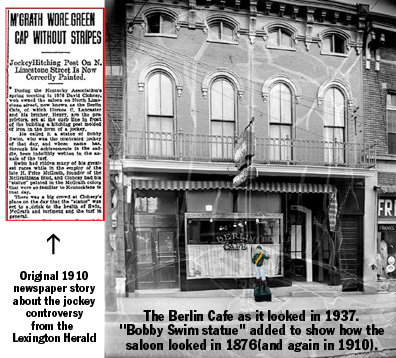
Click on picture for larger view.
Similar antique cast iron jockey statues like "Bobby Swim" can still be seen in Lexington's main historic district near downtown.
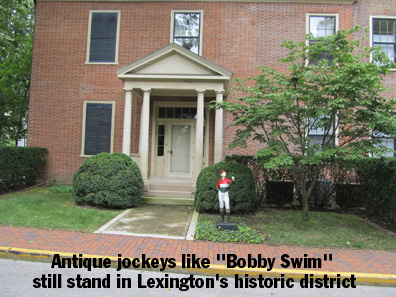
Click on picture for larger view.
Echoing the tradition of "Bobby Swim", painting of jockeys in the colorful silks of team owners made another big comeback with the opening of the new Keeneland race track in Lexington in 1936, coinciding with a resurgence in horse racing
in general after restrictive horse racing gambling laws were rolled back to stimulate the economy during the great depression. Two jockeys painted in the previous year's winning team's owners colors were placed on display in the Keeneland open-air paddock area in March 1938, an idea that was copied by race tracks throughout the country
over the following decades. No longer seen by pedestrians on the streets functioning as hitching posts, painted jockeys at race tracks were seen again in public- this time by millions of horse racing fans, and many for the first time. Jockey statues at race tracks directly contributed to a revival of the jockey hitching post as yard art in the 1950's.
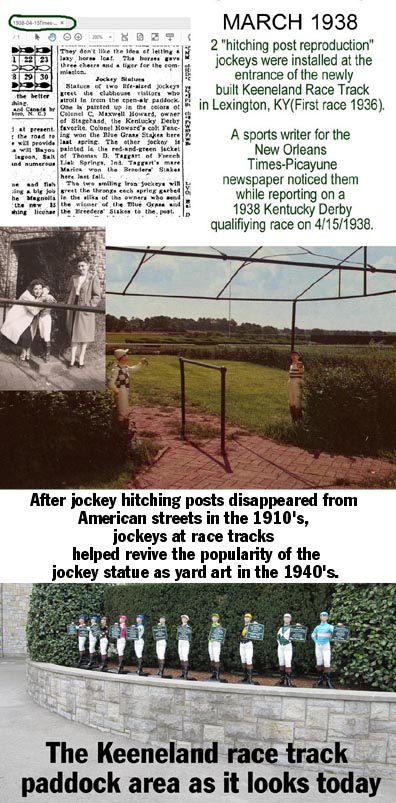
Click on picture for larger view.
Like our other Jocks, Designer Jocks are virtually maintenance-free and age gracefully. Just like other yard artwork, just hose him down when you're watering the flowers or set the spinkler
to hit him every now and then and he'll look great for years.
The Kentucky Blue Jock is fully-painted with white, blue, almond, brown and black oil-based enamels- the same kind of paint used on farm machinery and little red wagons that are used a lot and face the elements.
Paint is chip, fade, and UV resistant and will last for many years. The statue itself is made of non-rusting Aluminum so it too will last for generations.
A ring is included for the Kentucky Blue Jock's hand, but these Jocks also work well with our optional oil and solar lanterns(lantern sold separately- CLICK HERE for more information).
|
View of Designer Kentucky Blue Jock
CLICK ON PICTURES BELOW TO SEE LARGER VIEW
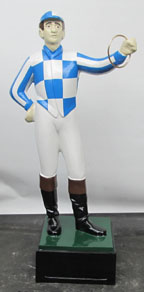
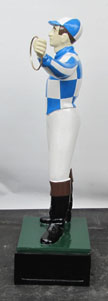
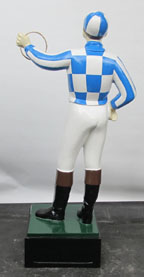

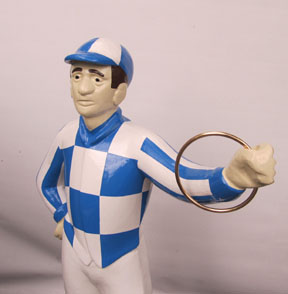
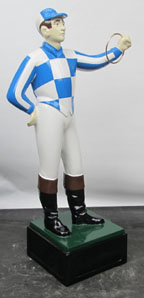
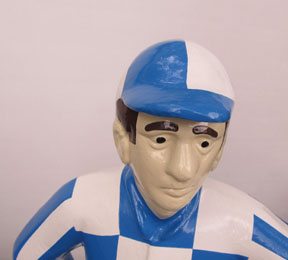
|
CLICK HERE to view Lawn Jockey dimensions
Kentucky Blue Lawn Jockey Statue #7460
Wrought Aluminium Lawn Jockey Statue on pedestal.
Jock is primed with standard automotive primer and then painted with 2 coats of standard oil-base enamel paint in the following color scheme as shown above:
Gloss Leather Brown: Hair and eyebrows, top of boots
Gloss Almond: Face and hands
Gloss White: Pants, cap 1/6ths, vest blocks, sleeve stripes
Gloss Sail Blue: vest blocks, sleeve stripes, cuffs, cap brim and button, cap 1/6ths
Gloss Black: Eyeballs, bottom of boots and base
Gloss Hunter Green: Top of base
Includes removable ring and repainting instructions for future reference.
$1000 with FREE SHIPPING INCLUDED(to continental U.S. only).
CLICK HERE for international and Hawaii shipping.
Aluminum doesn't rust, and is lightweight. Unit is hollow.
DIMENSIONS: approx. 46" tall including pedestal base. Pedestal base is 13" x 13" x 7". Shipping wt. 60 lbs.
Arrives fully assembled in a cardboard box by FedEx Ground.
Approx. time from order placement to delivery: 2 weeks.
|
 |
Credit Card Checkout
Total price: $1000. Shipping: FREE.
PAYMENT METHODS:
MasterCard, Visa, Discover, American Express accepted.
PROCEDURE:
We will send you an email receipt for your payment immediately following order placement. Upon shipment, we will send you an email with package tracking information.
Click "BUY NOW" button below to order. A shopping bag will appear on the bottom right of your screen. You can checkout by clicking the shopping bag  , or add other items then click the shopping bag when your order is complete. To delete items from shopping bag, click the shopping bag and then click the X in the upper right corner of item image you wish to delete , or add other items then click the shopping bag when your order is complete. To delete items from shopping bag, click the shopping bag and then click the X in the upper right corner of item image you wish to delete 
|
EXPRESS checkout
If you are having problems with the shopping cart or are just ordering this one item, you can use the express checkout "BUY NOW" button below:
Alternate PHONE checkout
For you prefer to order by PHONE rather than order online, CLICK HERE to contact us.
|
|
|

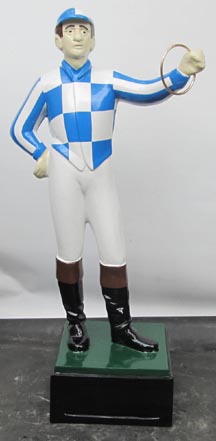
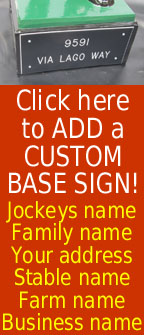
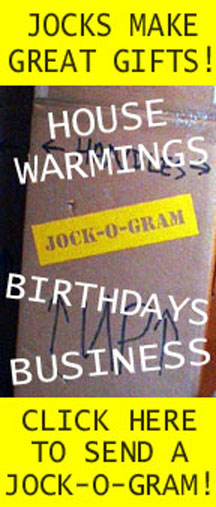
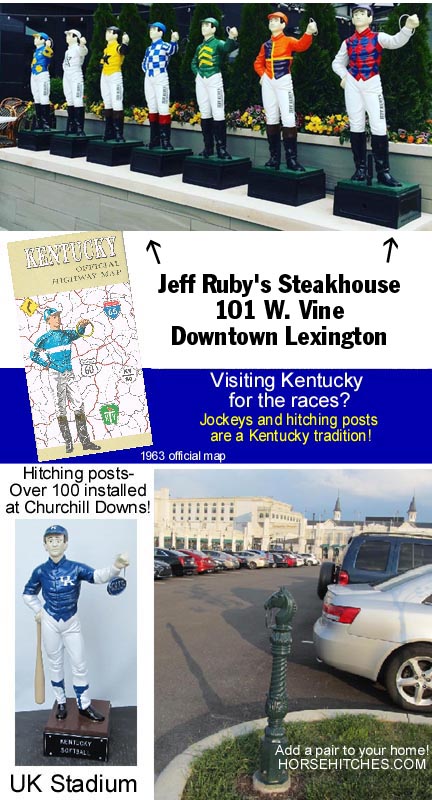











 , or add other items then click the shopping bag when your order is complete. To delete items from shopping bag, click the shopping bag and then click the X in the upper right corner of item image you wish to delete
, or add other items then click the shopping bag when your order is complete. To delete items from shopping bag, click the shopping bag and then click the X in the upper right corner of item image you wish to delete 